May 7, 2025
Ship Emergency Management: Six benefits of having real-time vessel data
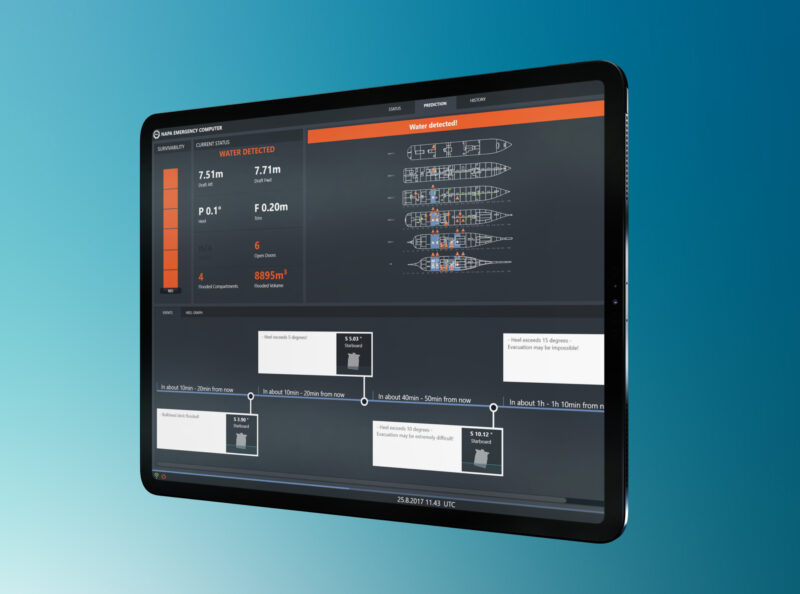
In flooding emergencies, every second matters. The NAPA Emergency Computer is designed to support precise decision-making and faster counteractions, helping crews respond swiftly and effectively.
When water is detected, onboard crew and shore-based teams must respond swiftly with the right actions to remedy and contain risk. By analyzing real-time vessel data, the ship crew and emergency response teams can assess the vessel’s damage extent. The insights derived from your ship’s real-time data inform the actions and decisions the crew and response teams take to manage emergency events. It can prevent catastrophic endings, as it expedites the emergency management process by crucial saving time lost in coordinating with the crew onboard and shoreside within the first hours of an emergency – the time where corrective actions could avert a disaster.
What is ship Emergency Response Service?
Emergency Response Service is a round-the-clock shore-based technical advisory service provided to shipping companies by a third-party company specialized in handling emergency response situations. Such emergency response service providers analyze a vessel’s salient data to assess damage extent and offer a ship’s crew the most feasible action plans for expediting a ship emergency.
Emergency response service providers offer technical advisory support for navigating hazardous ocean situations such as: maritime collisions, ship flooding, structural failure, stability loss, oil spills and navigational errors.
Processes Between Ship Operator and Emergency Response Service Provider
Ship emergency response process starts when a ship operator registers for emergency response services with their preferred provider. The vessel’s basic data is shared electronically and uploaded to the emergency response service provider’s system upon signing up. Examples of vessel characteristic data shared between operators and emergency response-service providers include:
- Vessel design data such as net tonnage, deadweight, and gross tonnage
- Vessel registration data such as class details, class1Code, and class2Code
- Vessel propulsion data such as propulsion type, main engine design, and main engine count
- Vessel bunker data, such as fuel type code, tank count, and fuel tank capacity
- Vessel dimensions data, such as keel-to-manifold, draught, air draught, and length overall
Upon receipt, the emergency response service provider validates the authenticity of the data and archives it. The integration between the two systems allows for real-time data updates. This way, when emergency response service providers receive an activation call due to an emergency, they can swiftly analyze the vessel characteristic data and the most recent data logged by a vessel’s master and offer viable solutions.
NAPA Emergency Computer’s Role
The NAPA Emergency Computer and NAPA Fleet Intelligence, therefore, work in tandem to increase safety and improve emergency management onboard passenger vessels. Here shoreside teams can leverage the NAPA Emergency Computer and the NAPA Fleet Intelligence features to improve the emergency management process.
The NAPA Emergency Computer empowers ship officers to continuously assess their vessels’ vulnerability and survivability. With real-time insights and automated predictions, it enhances emergency preparedness, helping crews take the right actions at the right time. Beyond emergencies, it also improves crew’s preparedness for such incidents by simulating real-life flooding scenarios.
For the shoreside teams, we have the NAPA Fleet Intelligence, a web-based cloud data service. NAPA Fleet Intelligence has a dedicated Emergency module that enables real-time and precise data sync between the ship, the shore and the emergency response service provider. It is designed to expedite information relay between these stakeholders and guarantees absolute data correctness.
Benefits of Having Real-Time Decision Support for the Onboard Crew
The ship’s onboard crew, including the captain, navigation officers, chief mate, and engineering officers, get real-time decision support.
1. Exact Situation Awareness with Vessel TRIAGE Categorization
Vessel TRIAGE is a simple, but effective method for assessing and communicating a ship’s vulnerability status in a marine distress situation. It uses color codes to represent vessels’ safety status.
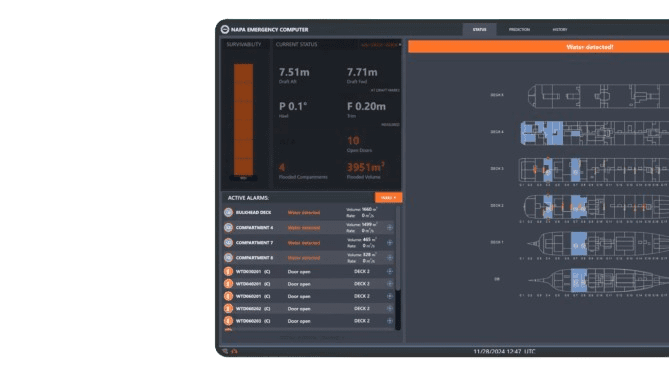
Typically, green color indicates no-risk, yellow color express low-risk status, while red and black represent high-risk status. Such straightforward communication alerts enhance the onboard crew’s awareness of the situation as they can immediately tell how severe a maritime distress situation is.
With real-time vessel TRIAGE categorization updates, ship crew monitor their vessel’s risk levels throughout a voyage.
The dashboard also provides real-time stability status, synchronized with NAPA Stability to ensure the most up-to-date calculations. Additionally, it monitors the watertight door status, tracking open doors, flooded compartments, and water volumes.
2. Automatic Damage Detection Based on Flooding Level Sensor Data
Thanks to modern flood detection sensors, automatic and real-time monitoring of flooding risks is now possible. NAPA’s ship stability and emergency management systems can analyze the data supplied to assess a vessel’s watertight integrity, water levels, and possible breach locations. This way, the system automatically defines damage levels, helping the onboard crew to prepare adequately.
3. Decision Support with Dynamic Survivability Prediction on a Timeline
The moment water is detected, the system activates automatically.
Alarms appear instantly, ensuring immediate awareness. The Survivability Prediction tab activates, and real-time calculations begin. Real-time water progression status is reflected on the dashboard, and predictions update automatically every few minutes to reflect the latest conditions. Thus, the crew can clearly assess the impact of their countermeasures.
The system also provides a future timeline, displaying how ship stability will change over the next 3.5 hours.
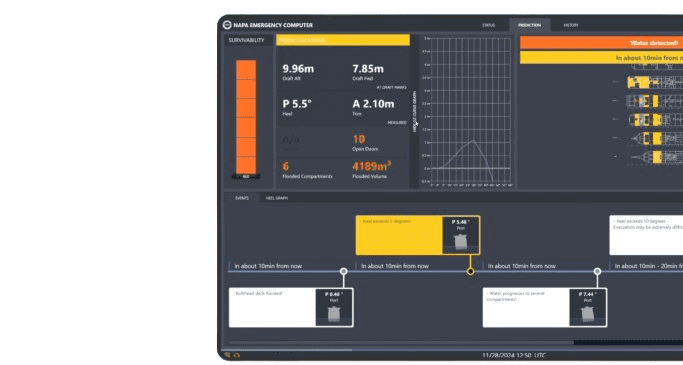
Using this insight, the onboard crew can chronologically see the effects of a distress situation. Crew members can select any event on the timeline to view key insights, including the flooded volume, GZ curve (a measure of stability), the heel graph (which shows ship heeling angle, and the evacuation limit, marked by an orange dashed line.
This data also empowers the onboard crew to make strategic decisions that improve the vessel’s survival rate in an emergency. As flooding progresses, the system continuously updates its predictions in real-time. It provides crucial advice directly on the timeline, answering key questions like:
- Should we evacuate?
- Can evacuation be delayed?
- Will the ship reach equilibrium stage, or is capsize imminent?
4. Smart Advisory Cards for Handling Flood Response
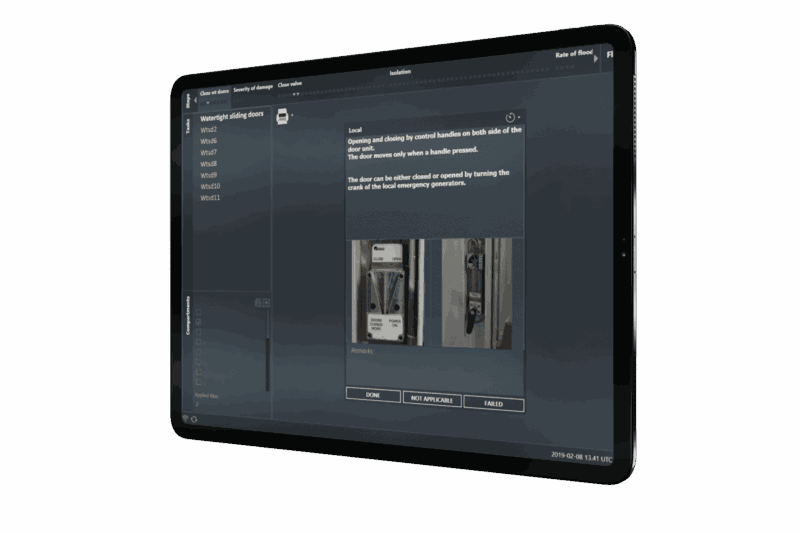
NAPA Emergency Computer provides dynamic advisory cards that guide crews through flooding emergencies with real-time, data-driven checklists. These cards adapt to the severity of the situation, offering either high-level operational steps or detailed multi-level task advisories. By integrating live flooding data, they ensure crews receive precise, situation-specific instructions to manage incidents effectively.
Benefits for Shoreside Teams and Emergency Response Service
Shoreside teams and emergency response-service providers operate from the shoreside, supporting shipboard crew during regular hours and emergency events. Shoreside advisory support is crucial in emergency ship events to guide the onboard crew through a crisis. As a ship’s crew focuses on immediate solutions to escape a risky situation, shoreside teams focus on finding strategic solutions that guide a ship throughout the voyage.
These two teams benefit from real-time vessel data in the following ways.
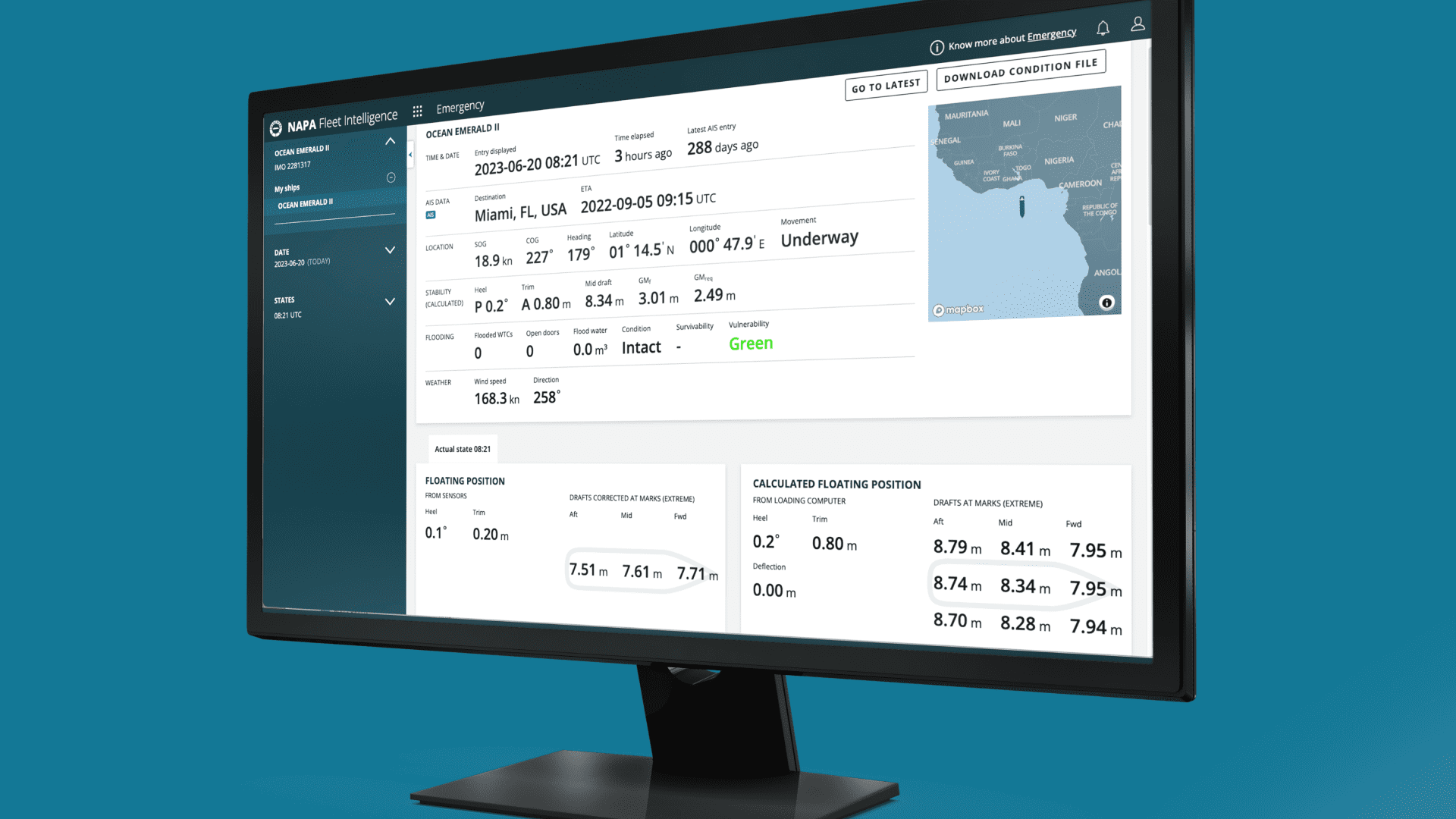
5. Real-Time Emergency Alerts for Shoreside Teams
The NAPA Fleet Intelligence Emergency module instantly updates shoreside teams of a vessel’s distress situation, eliminating the need for the crew to manually gather and transmit data. This allows fleet operations centers and emergency response providers to act immediately, supporting onboard teams without delay and ensuring a faster, more coordinated emergency response.
6. More Time for Shoreside Teams to Analyze and Act Strategically
When an incident happens, the Emergency Response Service needs the exact time of the incident, ship loading condition files before the incident and after the incident. NAPA’s Emergency module provides asnapshot of the ship data instantaneously.
By receiving real-time vessel data instantly, shoreside teams can focus on assessing the severity of an incident rather than waiting for updates. With more time and fewer information errors, they can develop precise mitigation plans that prioritize safety, reducing the likelihood of rushed or inaccurate decisions by the onboard crew under pressure.
Explore NAPA’s solutions for ship emergency management
NAPA Emergency Computer is designed for all passenger vessel types – from cruise to ferries, RoPax as well as mega-yachts. With an intuitive and user-friendly interface, it delivers real-time ship vulnerability status and survivability predictions within minutes, ensuring the crew has the right information to act quickly.
See how it can improve your fleet’s emergency preparedness.
